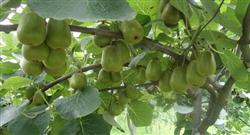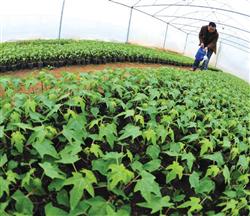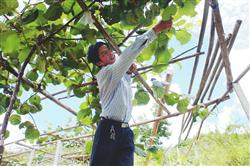Kiwifruit planting technology: how to manage kiwifruit in summer?

How to manage kiwifruit in summer? Please give guidance on the main management methods of kiwifruit in summer are as follows: first, wiping buds and picking hearts according to the principle of "early wiping buds, timely coring, and truncation of long branches", combined with the situation of the tree, it should be pruned many times in the growing period of kiwifruit in order to achieve the goal of high and stable yield. In the sprouting stage, the buds that are improperly positioned or too dense can be wiped off as early as possible; for the exuberant fruiting branches of the adult orchard, leave 8 words and 10 leaves above the fruiting part; coring the secondary branches germinated after the first coring, leaving 4 leaves; for the germinating tertiary branches, leaving 3 leaves; for the culturable overgrown or vegetative branches, leaving 10 leaves and 15 leaves for coring; the twigs of diseases and insect pests and weak twigs are generally removed from the base. The leaves of Hongyang kiwifruit are thinner and larger than other varieties, the stress resistance is poor, and the branches are slender and easy to break. In strong windy weather, you should always pay attention to binding branches and drawing vines. Most of the branches that are easy to be broken by the wind are the mother branches of good results in the second year. In case of hot and dry wind, where possible, you can spray water to the leaves to avoid hot and dry wind scald the leaves. Gradually improve the microclimate, so that kiwifruit in a warm and humid climate environment. Second, the early flowering stage of pollinated kiwifruit is in late April, the full flowering stage is in early May, and the last flowering stage is in late May. In the case of continuous overcast and rain, the florescence will be pollinated poorly, so artificial pollination should be carried out. The specific method is as follows: the male bud was collected in advance at flowering stage, and the pollen sac was removed and placed at 25 ℃ at room temperature. After one day and night, the pollen sac opened and the pollen could be collected. It was pollinated in two batches in the female florescence, and the pollination effect of the flowers blooming on the same day was good. The number of seeds in kiwifruit is proportional to the size of the fruit. If the fruit weighs 130 grams, the number of seeds in each fruit is 800ml 1200. The conventional artificial point pollination method needs repeated pollination to meet the requirements, while the liquid pollination method has the characteristics of fast pollination, concentrated and accurate pollination, prolonged pollination period, pollen saving and so on. Third, timely fruit thinning, strict fruit thinning, reasonable load, not the use of fruit hormone. In principle, the same inflorescence leaves a single fruit and removes the terminal fruit and tail fruit of the same branch. Fruit thinning should be carried out 15 days after anthesis, according to the principle of "keeping good and bad, big to small, sparse to dense, and middle to base" to remove deformed fruit, weak small fruit, overlapping fruit, disease and insect fruit. In general, there are 2 fruits in the short fruit branch, 5 fruit in the middle fruit branch and 6 fruit in the long fruit branch. In order to grow better fresh fruit, bagging branch technique is more effective where there are conditions. 15 days after pollination, the second foliar fertilizer was sprayed, and 0.3% urea and potassium dihydrogen phosphate were still mixed with Merrill Lynch efficient calcium. After that, it was sprayed once every 15 days, five times in a row. After the young fruit stopped growing for the first time, the strong fruit fertilizer was applied with potassium and nitrogen as the main application. Fourth, soil management is the basis of good growth of kiwifruit. Kiwifruit roots are fleshy roots, and 70% of the roots grow in parallel. In the management, it is required that the small trees leave a 1-meter tree plate and the big trees leave 2-meter tree plates not to interplant other crops. The whole garden is intercropped with high-stem crops. In the tree plate, weeding and loosening the soil should be done frequently to keep the soil breathable. Fertilizing and weeding should be as shallow as possible so as not to hurt the main root. Where conditions permit, high-quality green manure can be planted on the tree plate or in the whole garden, and no-tillage method can be implemented. Summer fertilization, should "eat less and eat more", in principle to avoid the use of high concentration of chemical fertilizer. Spray foliar fertilizer, spray water-soluble Merrill Lynch high-efficiency calcium. In case of high temperature and drought, irrigation should be made before 11:00 or after 4: 00 in the afternoon when the ground temperature is low, and combined irrigation should be covered with rice straw, wheat straw and weeds to achieve the purpose of drought resistance and moisturization. Fifth, pest control flower bud maggots mostly occur in April-May, which will cause a large number of falling flowers and fruits, so it is necessary to prevent and control them in time. From June to September, control soft rot, brown spot and other diseases. Click to get more kiwifruit planting techniques click to get more fruit planting techniques
- Prev

Papaya planting techniques: how to raise seedlings?
How to raise seedlings of papaya? Please introduce the methods of papaya seedling breeding and propagation techniques as follows: first, seed collection and seed treatment selection of fruit trees without diseases and insect pests in the full fruit period can be picked around the middle of September every year, when most of the fruit bark turns yellow, the seeds can be taken out, empty and shrunken seeds are selected, and then 0.1-0 is used.
- Next

Kiwifruit planting techniques: how to cut kiwifruit in summer?
How to cut kiwifruit in summer? Please give instructions for planting kiwifruit can refer to the following methods for summer cutting: first, if the sprouts on the trunk, main vine and lateral vines are improperly positioned or too dense or overlapping, they should be erased at any time. The sooner you sprout, the better. On the general robust fruiting mother branch, 5-6 fruiting branches can reach abundant.
Related
- Moge, come on! The staff of the peasant association in the producing area of cantaloupe were frightened when the crowd gathered.
- Causes and Solutions of low Fruit setting rate of Apple
- Symptoms and control measures of passion fruit virus disease
- Fruit growing lesson: how do apple orchards keep high yields?
- Can you build orchards in the mountains? What are the pros and cons?
- How to manage the coloring period of Crisson grape?
- This paper introduces the processing technology of two kinds of fig products.
- How much is a month for retired teachers in rural areas by 2020?
- How can strawberry planting increase sugar content? We should pay attention to management in many aspects.
- What are the cultivation techniques on how to improve the yield of golden fruit?

